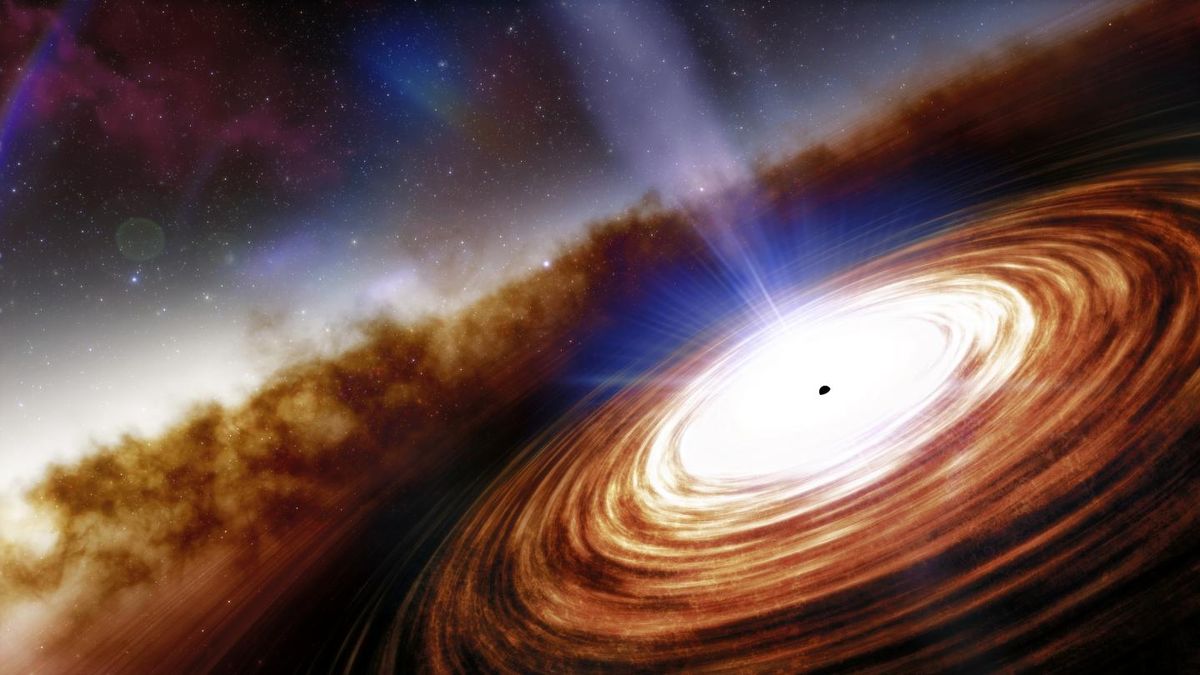The most distant quasar ever found is hiding a seriously supermassive black hole

In a breakthrough discovery, scientists have found the most distant quasar yet known — and it’s home to a seriously supermassive black hole.
Astronomers led by researchers at the University of Arizona spotted the brilliant quasar about 13.03 billion light-years from Earth. Quasars are among the brightest objects in the universe, quasars are luminous, active galactic nuclei powered by supermassive black holes that are actively feeding on nearby material.
When this material gets sucked in, quasars release ultra-bright beams of electromagnetic radiation. Scientists suspect that these glowing, ultramassive objects could actually be an evolutionary stage for some galaxies. In fact, scientists estimate that, on average, this particular quasar’s black hole ingests an amount of mass equivalent to 25 suns every year.
This quasar, called J0313-1806, can be dated back to just 670 million years after the Big Bang (the universe at this time was a mere 5% of its current age), making it the most distant and earliest quasar ever found. This quasar also hosts a supermassive black hole that has a mass equal to 1.6 billion of our suns.
The Universe: From the Big Bang to now in 10 easy steps
A record-breaking quasar
While this newfound quasar is astoundingly old and far away, the team’s observations also showed evidence that there is a wind of super-heated gas flowing from around the galaxy’s supermassive black hole, with this gas traveling at one fifth the speed of light, according to a statement. If this strong quasar-driven wind coming from the most distant quasar ever spotted wasn’t interesting enough, the team also found extremely active star formation activity in the galaxy holding the quasar.
J0313-1806 is estimated to create about 200 solar masses every single year, compared to our Milky Way’s one solar mass per year, according to the statement.
“This is a relatively high star formation rate, similar to that observed in other quasars of similar age, and it tells us the host galaxy is growing very fast,” lead author Feige Wang, a Hubble Fellow at the University of Arizona’s Steward Observatory, said in the same statement.
Quasar investigation
Now, because of their close relationship, scientists think that, by studying quasars, they can learn more about how the objects came to be and how supermassive black holes really behave.
While this quasaris only 20 million light-years farther from Earth than the one that last held the title of “farthest quasar,” the new record-holder’s supermassive black hole is about twice as heavy as that of its predecessor. This detail could change how scientists understand the relationship between these supermassive, super-bright cosmic objects.
“This is the earliest evidence of how a supermassive black hole is affecting its host galaxy around it,” Wang said. “From observations of less distant galaxies, we know that this has to happen, but we have never seen it happening so early in the universe.”
Related: The strangest black holes in the universe
How do you make a supermassive black hole
Quasars like J0313-1806 that already accumulated such immensely massive black holes in such a short time in the early universe have puzzled scientists for years. While black holes can be created when stars explode in supernova and collapse and smaller black holes can merge, eventually building up mass, these ultra-massive early-universe quasars remain mysterious. How did they get so massive so quickly?
With this “new” quasar to study, this team is narrowing in on how such a supermassive black hole could have gained such mass and formed in such a short amount of time. The quasar’s black hole is too massive to be explained by some former theories. In fact, the team thinks that, even if the black hole formed as early as 100 million years after the Big Bang and grew as fast as possible, it would still only be 10,000 times as massive as our sun — and it’s 1.6 billion times as massive.
“This tells you that no matter what you do, the seed of this black hole must have formed by a different mechanism,” co-author Xiaohui Fan, a professor and associate head of the Department of Astronomy at the University of Arizona. “In this case, one that involves vast quantities of primordial, cold hydrogen gas directly collapsing into a seed black hole … “In order for the black hole to have grown to the size we see with J0313-1806, it would have to have started out with a seed black hole of at least 10,000 solar masses, and that would only be possible in the direct collapse scenario.”
The team hopes to find more quasars “born” around this same time in the early universe to help them explore further and better understand how such massive, powerful objects came to be.
“Our quasar survey covers a very wide field, allowing us to scan almost half of the sky,” co-author Jinyi Yang, a Peter A. Strittmatter Fellow at the Steward Observatory, said in the same statement. “We have selected more candidates on which we will follow up with more detailed observations.”
Yang added that future observations with a space-based telescope like NASA’s James Webb Space Telescope could propel such research even further.
“With ground-based telescopes, we can only see a point source,” Wang said. “Future observations could make it possible to resolve the quasar in more detail, show the structure of its outflow and how far the wind extends into its galaxy, and that would give us a much better idea of its evolutionary stage.”
This work has been accepted for publication in the journal Astrophysical Journal Letters and was presented Jan. 12, 2021 at the 237th meeting of the American Astronomical Society.
Email Chelsea Gohd at cgohd@space.com or follow her on Twitter @chelsea_gohd. Follow us on Twitter @Spacedotcom and on Facebook.
